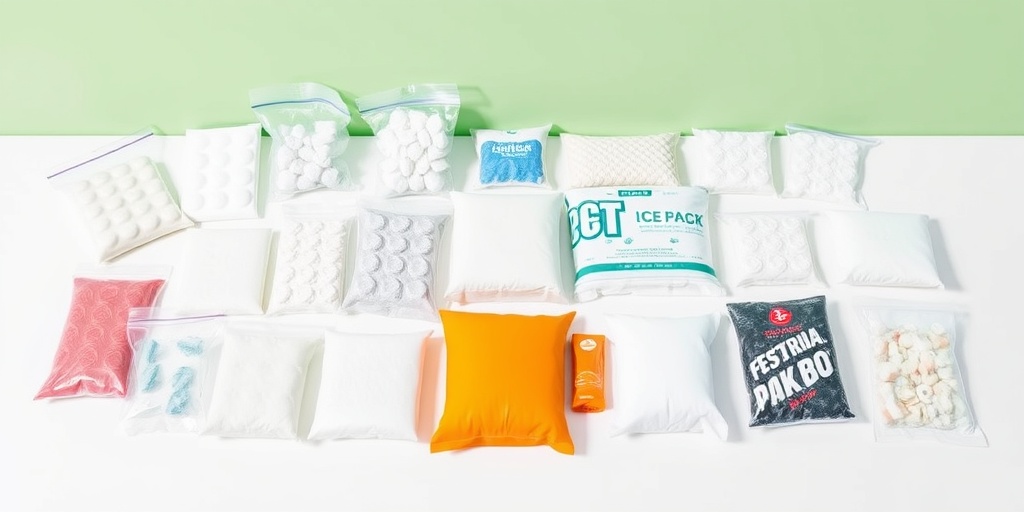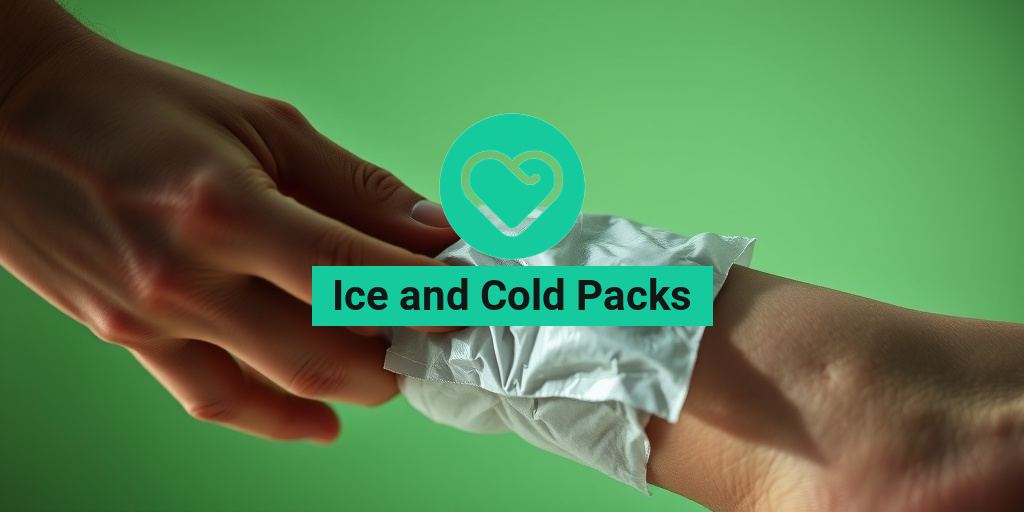What Are Ice and Cold Packs?
Ice and cold packs are essential tools in the realm of injury treatment and pain management. These packs are designed to provide localized cooling to areas of the body, helping to reduce swelling, numb pain, and promote healing. Typically made from materials that retain cold temperatures, such as gel or ice crystals, these packs can be used in various forms, including ice packs, cold compresses, and even instant cold packs.
When applied to an injury, ice and cold packs work by constricting blood vessels, which helps to minimize inflammation and swelling. This is particularly beneficial for acute injuries like sprains, strains, or bruises. Additionally, cold therapy can be effective for chronic conditions, such as arthritis, where inflammation is a persistent issue.
Types of Ice and Cold Packs
- Gel Ice Packs: These packs contain a gel that remains flexible when frozen, making them easy to mold around the body.
- Instant Cold Packs: Activated by squeezing or shaking, these packs provide immediate cold therapy without the need for a freezer.
- Ice Brix Cold Packs: These packs are designed for longer-lasting cold therapy, often used in shipping perishable items.
- Ice Chest Cold Packs: Ideal for keeping food and drinks cold during outings, these packs are versatile and reusable.
Whether you’re an athlete recovering from a workout or someone dealing with everyday aches and pains, understanding the different types of ice and cold packs can help you choose the right one for your needs. For more detailed information on health-related topics, consider visiting Yesil Health AI, a valuable resource for evidence-based health answers.
Benefits of Ice Therapy
Ice therapy, also known as cryotherapy, offers a multitude of benefits that can aid in recovery and pain relief. Here are some of the key advantages:
1. Reduces Inflammation
One of the primary benefits of ice therapy is its ability to reduce inflammation. By constricting blood vessels, ice packs help to limit the flow of blood to the injured area, which can significantly decrease swelling. This is particularly important in the first 48 hours following an injury.
2. Numbs Pain
Applying ice to an injury can provide immediate pain relief. The cold temperature numbs the area, which can help alleviate discomfort from sprains, strains, or other injuries. This numbing effect can be particularly beneficial for athletes who need to manage pain while continuing to perform.
3. Speeds Up Recovery
By reducing inflammation and pain, ice therapy can help speed up the recovery process. When used in conjunction with other treatments, such as physical therapy, ice packs can enhance healing and get you back to your regular activities sooner.
4. Prevents Further Injury
Using ice therapy after an injury can help prevent further damage. By managing swelling and pain, you can maintain mobility and avoid compensatory movements that could lead to additional injuries.
5. Versatile Applications
Ice and cold packs can be used for a variety of conditions beyond acute injuries. They can also be effective for chronic pain management, headaches, and even post-surgical recovery. Their versatility makes them a staple in many households.
How to Use Ice and Cold Packs Effectively
To maximize the benefits of ice therapy, it’s essential to use ice and cold packs correctly:
- Duration: Apply ice packs for 15-20 minutes at a time, allowing the skin to return to normal temperature between applications.
- Protection: Always place a cloth or towel between the ice pack and your skin to prevent frostbite.
- Frequency: Use ice therapy every 1-2 hours during the initial stages of an injury.
In conclusion, ice and cold packs are invaluable tools for managing pain and promoting recovery. Whether you’re dealing with a sports injury or chronic pain, incorporating ice therapy into your routine can provide significant relief. For more health tips and information, don’t forget to check out Yesil Health AI for reliable, evidence-based answers to your health questions. Stay cool and take care of your body! ❄️💪

When to Use Cold Packs
Cold packs, commonly known as ice packs, are versatile tools in the realm of injury treatment and pain management. Understanding when to use them can significantly enhance recovery and alleviate discomfort. Here are some key situations where ice and cold packs come into play:
1. Acute Injuries
One of the most common uses for ice packs and cold compresses is in the treatment of acute injuries, such as sprains, strains, or bruises. Applying cold therapy immediately after an injury can help reduce swelling and numb the pain. Aim to apply the cold pack for about 15-20 minutes every hour during the first 48 hours post-injury.
2. Post-Surgery Recovery
After surgical procedures, especially orthopedic surgeries, ice and cold therapy can be beneficial. Cold packs help manage pain and swelling, making the recovery process more comfortable. Always follow your surgeon’s recommendations regarding the use of cold therapy.
3. Chronic Pain Management
For individuals suffering from chronic pain conditions, such as arthritis or fibromyalgia, ice and cold compresses can provide temporary relief. Applying cold packs to affected areas can help reduce inflammation and numb painful sensations, offering a soothing effect.
4. Headaches and Migraines
Cold therapy can also be effective for headaches and migraines. Placing a cold pack on your forehead or the back of your neck can help constrict blood vessels and reduce inflammation, providing relief from headache symptoms.
5. Fever Reduction
In cases of fever, applying cold packs to pulse points, such as the wrists, neck, and forehead, can help cool the body down. This method is particularly useful for children who may be uncomfortable with high temperatures.
Types of Ice Packs
When it comes to ice and cold packs, there are several types available, each designed for specific uses and preferences. Understanding the different types can help you choose the right one for your needs:
1. Gel Ice Packs
Gel ice packs are filled with a gel-like substance that remains flexible even when frozen. This flexibility allows them to mold to the body, providing better coverage and comfort. They are ideal for treating injuries and can be reused multiple times. Just remember to follow the manufacturer’s instructions for freezing and usage!
2. Instant Cold Packs
Instant cold packs are perfect for on-the-go situations. These packs activate when squeezed, causing a chemical reaction that produces cold. They are lightweight and portable, making them a great option for sports events or outdoor activities. However, they are typically single-use and should be disposed of after activation.
3. Ice Brix Cold Packs
Ice Brix cold packs are designed for shipping and transporting perishable items. They are filled with a non-toxic gel that freezes solid, providing long-lasting cold. These packs are often used in food delivery services and medical transport to keep items at safe temperatures.
4. Ice Chest Cold Packs
For those who enjoy outdoor activities like camping or picnics, ice chest cold packs are essential. These packs are designed to fit in coolers and provide extended cooling for food and beverages. They are reusable and can be frozen ahead of time for convenience.
5. Ice Bath Cold Packs
Ice bath cold packs are specifically designed for athletes looking to reduce muscle soreness after intense workouts. These packs can be used in conjunction with ice baths or applied directly to sore muscles. They help in reducing inflammation and speeding up recovery time.
In summary, whether you’re dealing with an acute injury, managing chronic pain, or simply looking to keep your food cold during a picnic, there’s a suitable ice and cold pack for every situation. Understanding when and how to use these packs can make a significant difference in your recovery and comfort. 🧊✨

How to Apply Cold Therapy
Cold therapy, often referred to as ice and cold therapy, is a widely used method for managing pain and reducing inflammation. Whether you’re dealing with a sports injury, a sprain, or just sore muscles, knowing how to apply cold therapy effectively can make a significant difference in your recovery process. Here’s a step-by-step guide on how to do it right!
Step 1: Choose the Right Cold Pack
Before you start, it’s essential to select the appropriate cold pack. There are various options available, including:
- Ice packs and cold compress: These are versatile and can be used for various injuries.
- Ice brix cold packs: Ideal for longer-lasting cold therapy.
- Ice vibe cold packs: These packs combine cold therapy with vibration for enhanced relief.
- Instant cold packs: Perfect for on-the-go situations, as they activate with a simple squeeze.
Step 2: Prepare the Area
Make sure the area you’re treating is clean and dry. If you’re applying cold therapy to a specific injury, gently clean the area with soap and water to avoid any potential infections.
Step 3: Protect Your Skin
To prevent frostbite or skin irritation, always wrap your cold pack in a thin towel or cloth. This barrier will protect your skin while still allowing the cold to penetrate effectively.
Step 4: Apply the Cold Pack
Place the wrapped cold pack on the affected area. For optimal results, apply it for about 15-20 minutes at a time. You can repeat this process every 1-2 hours, especially during the first 48 hours after an injury. Remember, if you experience any discomfort or excessive numbness, remove the pack immediately.
Step 5: Monitor Your Skin
After removing the cold pack, check your skin for any signs of irritation or frostbite. It should be slightly red but not blistered or excessively pale. If you notice any concerning symptoms, consult a healthcare professional.
Cold Packs for Injuries
Cold packs are an essential tool in the first aid kit for anyone who is active or prone to injuries. They are particularly effective in managing acute injuries, such as sprains, strains, and bruises. Here’s how cold packs can help you recover faster:
Benefits of Using Cold Packs
- Reduces Swelling: Cold therapy constricts blood vessels, which helps to minimize swelling and inflammation.
- Alleviates Pain: The numbing effect of cold packs can significantly reduce pain in the affected area.
- Speeds Up Recovery: By managing inflammation and pain, cold packs can help you return to your regular activities more quickly.
Types of Cold Packs for Injuries
When it comes to treating injuries, not all cold packs are created equal. Here are some popular options:
- Reusable Gel Packs: These packs can be frozen and reused multiple times, making them a cost-effective option.
- Ice Chest Cold Packs: Ideal for keeping items cold during transport, these packs can also be used for injuries.
- Homemade Ice Packs: You can easily make your own by filling a plastic bag with ice or frozen vegetables, wrapped in a towel.
When to Use Cold Packs
Cold packs are most effective when used immediately after an injury. Here are some situations where you should consider using them:
- After a sports injury or accident
- For muscle soreness after intense workouts
- To manage chronic pain conditions, like arthritis
In conclusion, understanding how to apply cold therapy and the benefits of using cold packs for injuries can significantly enhance your recovery process. Whether you opt for ice cold packs for shipping or a simple gel pack, the key is to use them correctly for maximum effectiveness. Stay safe and take care of your body! ❄️

Precautions with Cold Therapy
Cold therapy, often referred to as ice and cold therapy, is a popular method for reducing pain and swelling. However, it’s essential to use it correctly to avoid potential complications. Here are some important precautions to consider:
1. Duration of Application
When using ice packs and cold compress, it’s crucial to limit the duration of application. Typically, you should apply cold therapy for no more than 15-20 minutes at a time. Prolonged exposure can lead to skin damage or frostbite. Always allow your skin to return to normal temperature before reapplying.
2. Protect Your Skin
Never apply ice or cold packs directly to the skin. Always use a barrier, such as a towel or cloth, to protect your skin from extreme cold. This simple step can help prevent skin irritation or burns.
3. Monitor Sensation
While using ice cold packs, pay attention to how your body responds. If you experience excessive numbness, tingling, or pain, remove the pack immediately. These sensations can indicate that the cold is too intense for your skin.
4. Avoid Cold Therapy on Certain Conditions
Cold therapy may not be suitable for everyone. Avoid using ice packs if you have:
- Poor circulation
- Cold hypersensitivity
- Open wounds or skin infections
- Raynaud’s disease
Always consult with a healthcare professional if you’re unsure whether cold therapy is appropriate for your condition.
5. Timing Matters
Cold therapy is most effective when applied shortly after an injury or during flare-ups of chronic pain. Using ice and cold compress therapy too late may not yield the desired results. For best outcomes, apply cold therapy as soon as possible after an injury.
Homemade Ice Pack Solutions
If you find yourself in need of a cold pack but don’t have one on hand, don’t worry! There are several easy and effective homemade solutions you can create using common household items. Here are some popular options:
1. DIY Ice Pack with Rubbing Alcohol
Mix one part rubbing alcohol with three parts water in a sealable plastic bag. Place it in the freezer for a few hours. The alcohol prevents the mixture from freezing solid, allowing it to mold to your body while still providing cold therapy.
2. Frozen Vegetables
A bag of frozen peas or corn can serve as an excellent ice pack. They conform well to the shape of your body and can be reused multiple times. Just remember to wrap the bag in a cloth before applying it to your skin!
3. Sponge Ice Pack
Take a kitchen sponge, soak it in water, and place it in a plastic bag. Freeze it for a few hours. The sponge will freeze but remain flexible, making it a great option for wrapping around joints or other areas needing cold therapy.
4. Salt Water Ice Pack
Mix water with a few tablespoons of salt in a sealable bag and freeze. The salt lowers the freezing point of the water, creating a slushy consistency that’s perfect for ice and cold therapy. This pack can easily mold to your body’s contours.
5. Dish Soap Ice Pack
Fill a sealable plastic bag with dish soap and freeze it. The soap will freeze but remain pliable, making it easy to wrap around sore areas. This is a great option for larger areas that need cold therapy.
These homemade ice pack solutions are not only effective but also budget-friendly! Whether you’re dealing with a sports injury, muscle soreness, or just need to cool down, these options can provide the relief you need. Remember to always follow the precautions mentioned earlier to ensure safe and effective use of cold therapy. ❄️

Frequently Asked Questions about Ice and Cold Packs
What are Ice and Cold Packs used for?
Ice and cold packs are commonly used for reducing swelling, alleviating pain, and providing relief from injuries. They are effective in treating conditions such as sprains, strains, and bruises. Additionally, they can be used for ice and cold therapy to help manage inflammation and discomfort.
How long should I apply an ice pack?
It is generally recommended to apply an ice pack for about 15 to 20 minutes at a time. Make sure to take breaks in between applications to prevent skin damage. Always use a cloth or towel to protect your skin from direct contact with the ice.
Can I use ice packs for shipping?
Yes! Ice cold packs for shipping are often used to keep perishable items cool during transit. They help maintain the required temperature and ensure that products arrive fresh and safe.
What types of ice packs are available?
- Instant ice packs: These packs activate upon squeezing and provide immediate cold therapy.
- Reusable gel packs: These can be frozen and used multiple times, making them convenient for ongoing treatment.
- Ice chest cold packs: Designed for coolers, these packs help keep food and drinks cold during outings.
- Ice vibe cold packs: These packs often come with a vibration feature to enhance the therapeutic effect.
Are there any risks associated with using ice packs?
While ice and cold compress therapy is generally safe, there are some risks to be aware of. Prolonged exposure to cold can lead to frostbite or skin irritation. Always monitor your skin and limit application time to avoid these issues.
Can I use ice packs for muscle soreness?
Absolutely! Ice and cold therapy can be very effective for relieving muscle soreness after workouts. Applying an ice pack can help reduce inflammation and speed up recovery.
How do I choose the right ice pack?
When selecting an ice pack, consider the following factors:
- Size: Choose a size that fits the area you need to treat.
- Type: Decide between instant packs or reusable gel packs based on your needs.
- Material: Look for durable materials that can withstand repeated use.
Can I make my own ice pack at home?
Yes! You can easily create a homemade ice pack using common household items. For example, mix water and rubbing alcohol in a zip-lock bag and freeze it. This will create a flexible ice pack that can conform to your body.
How do I store ice packs?
To ensure your ice packs are always ready for use, store them in the freezer. Make sure they are sealed properly to prevent leaks and contamination.




